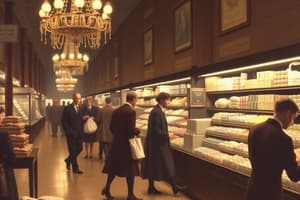Podcast
Questions and Answers
What was the approximate percentage of Americans who had a middle-class standard of living by 1960?
What was the approximate percentage of Americans who had a middle-class standard of living by 1960?
- 40%
- 60% (correct)
- 70%
- 80%
What was the percentage of Americans who owned at least one car by 1960?
What was the percentage of Americans who owned at least one car by 1960?
- 60%
- 70%
- 90%
- 80% (correct)
Who were some of the critics of the 1950s consensus?
Who were some of the critics of the 1950s consensus?
- Eleanor Roosevelt and Harry Truman
- A. Philip Randolph and Martin Luther King Jr.
- C. Wright Mills, David Riesman, and John Kenneth Galbraith (correct)
- Richard Nixon and Dwight Eisenhower
What was the significant event that challenged segregation in California schools?
What was the significant event that challenged segregation in California schools?
What was the significance of Levittown in New York?
What was the significance of Levittown in New York?
What was the percentage of Americans who owned two or more cars by 1960?
What was the percentage of Americans who owned two or more cars by 1960?
What was the name of the crusade led by A. Philip Randolph during World War II?
What was the name of the crusade led by A. Philip Randolph during World War II?
What was the landmark Supreme Court case that ruled segregation in public schools was unconstitutional?
What was the landmark Supreme Court case that ruled segregation in public schools was unconstitutional?
What was a significant challenge faced by African Americans in the 1950s?
What was a significant challenge faced by African Americans in the 1950s?
What best describes the economic situation in the United States between 1946 and 1960?
What best describes the economic situation in the United States between 1946 and 1960?
Study Notes
The 1950s: Consensus and Protest
- The 1950s was a period of consensus, particularly for white males, who had a high standard of living and enjoyed economic prosperity.
Economy and Affluence
- Between 1946 and 1960, Americans experienced a period of economic expansion, with gross national product more than doubling.
- Standards of living rose, and many Americans enjoyed a middle-class lifestyle, with access to consumer goods and services.
- By 1960, an estimated 60% of Americans had a middle-class standard of living.
Suburbanization and Car Culture
- The 1950s saw the rise of suburbanization, with the number of homes in the United States doubling during the decade.
- Levittown in New York was a classic example of suburbanization, with 10,000 almost identical homes built and 40,000 people moving in.
- Car culture became prominent, with 80% of Americans owning at least one car by 1960 and 14% owning two or more.
Criticism of the 1950s Consensus
- Some critics, such as C. Wright Mills, David Riesman, and John Kenneth Galbraith, argued that the emphasis on consumerism and conformity was problematic.
- They believed that the celebration of the middle-class lifestyle was displacing other conceptions of citizenship.
The Emergence of the Civil Rights Movement
- Rigid segregation was the norm throughout the country, especially in housing, jobs, and employment.
- African Americans faced significant barriers to education, with sub-standard segregated schools and limited opportunities.
- The Civil Rights Movement began to take shape in the 1950s, with efforts to desegregate schools and challenge segregation.
Key Figures and Events
- A. Philip Randolph and the Double-V crusade during WW2
- Mendez v. Westminster (1946): California Supreme Court ruled that Orange County had to desegregate its schools.
- Brown v. Board of Education (1954): Supreme Court ruled that segregation in public schools was unconstitutional.
- Rosa Parks and the Montgomery Bus Boycott (1955): Parks' refusal to move to the back of a bus sparked a 381-day boycott.
- Martin Luther King Jr.: Emerged as a key figure in the Civil Rights Movement, playing a crucial role in the Montgomery Bus Boycott and later forming the Southern Christian Leadership Conference.
Massive Resistance and Integration
- The Brown v. Board of Education ruling was met with "Massive Resistance" in the South, with some counties closing their schools rather than integrating.
- Eisenhower sent federal troops to Little Rock, Arkansas, to enforce integration in 1957.
- By the end of the 1950s, fewer than 2% of black students attended integrated schools in the South.
The 1950s: Consensus and Protest
Economy and Affluence
- Americans experienced economic expansion between 1946 and 1960, with gross national product more than doubling.
- Standards of living rose, and many Americans enjoyed a middle-class lifestyle, with access to consumer goods and services.
- By 1960, an estimated 60% of Americans had a middle-class standard of living.
Suburbanization and Car Culture
- The number of homes in the United States doubled during the 1950s.
- Levittown in New York was a classic example of suburbanization, with 10,000 almost identical homes built and 40,000 people moving in.
- By 1960, 80% of Americans owned at least one car, and 14% owned two or more.
Criticism of the 1950s Consensus
- Critics like C.Wright Mills, David Riesman, and John Kenneth Galbraith argued that the emphasis on consumerism and conformity was problematic.
- They believed that the celebration of the middle-class lifestyle was displacing other conceptions of citizenship.
The Emergence of the Civil Rights Movement
- Rigid segregation was the norm throughout the country, especially in housing, jobs, and education.
- African Americans faced significant barriers to education, with sub-standard segregated schools and limited opportunities.
- Efforts to desegregate schools and challenge segregation emerged in the 1950s.
Key Figures and Events
- A. Philip Randolph led the Double-V crusade during World War II.
- The California Supreme Court ruled that Orange County had to desegregate its schools in the 1946 Mendez v. Westminster case.
- The 1954 Brown v. Board of Education ruling declared segregation in public schools unconstitutional.
- Rosa Parks' refusal to move to the back of a bus in 1955 sparked the 381-day Montgomery Bus Boycott.
- Martin Luther King Jr. emerged as a key figure in the Civil Rights Movement, playing a crucial role in the Montgomery Bus Boycott and later forming the Southern Christian Leadership Conference.
Massive Resistance and Integration
- The Brown v. Board of Education ruling was met with "Massive Resistance" in the South, with some counties closing their schools rather than integrating.
- Eisenhower sent federal troops to Little Rock, Arkansas, to enforce integration in 1957.
- By the end of the 1950s, fewer than 2% of black students attended integrated schools in the South.
Studying That Suits You
Use AI to generate personalized quizzes and flashcards to suit your learning preferences.
Description
This quiz covers the economic prosperity and social trends of 1950s America, including the rise of the middle class and consumer culture.




